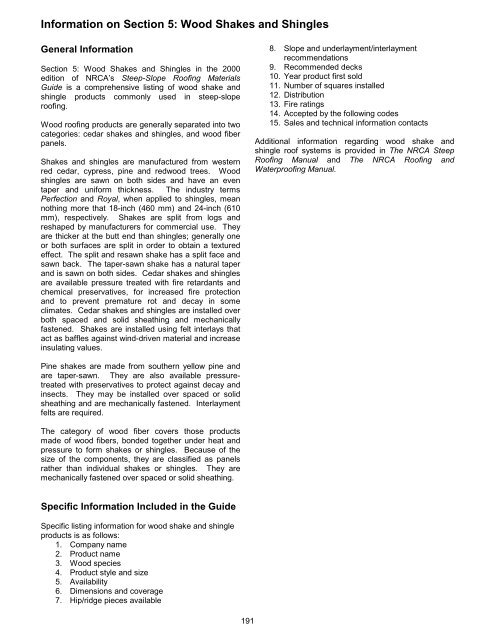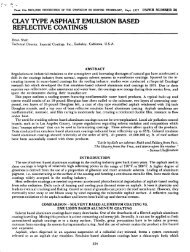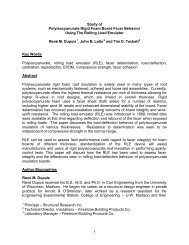2000 by the National Roofing Contractors Association. No
2000 by the National Roofing Contractors Association. No
2000 by the National Roofing Contractors Association. No
You also want an ePaper? Increase the reach of your titles
YUMPU automatically turns print PDFs into web optimized ePapers that Google loves.
Information on Section 5: Wood Shakes and Shingles<br />
General Information<br />
Section 5: Wood Shakes and Shingles in <strong>the</strong> <strong>2000</strong><br />
edition of NRCA’s Steep-Slope <strong>Roofing</strong> Materials<br />
Guide is a comprehensive listing of wood shake and<br />
shingle products commonly used in steep-slope<br />
roofing.<br />
Wood roofing products are generally separated into two<br />
categories: cedar shakes and shingles, and wood fiber<br />
panels.<br />
Shakes and shingles are manufactured from western<br />
red cedar, cypress, pine and redwood trees. Wood<br />
shingles are sawn on both sides and have an even<br />
taper and uniform thickness. The industry terms<br />
Perfection and Royal, when applied to shingles, mean<br />
nothing more that 18-inch (460 mm) and 24-inch (610<br />
mm), respectively. Shakes are split from logs and<br />
reshaped <strong>by</strong> manufacturers for commercial use. They<br />
are thicker at <strong>the</strong> butt end than shingles; generally one<br />
or both surfaces are split in order to obtain a textured<br />
effect. The split and resawn shake has a split face and<br />
sawn back. The taper-sawn shake has a natural taper<br />
and is sawn on both sides. Cedar shakes and shingles<br />
are available pressure treated with fire retardants and<br />
chemical preservatives, for increased fire protection<br />
and to prevent premature rot and decay in some<br />
climates. Cedar shakes and shingles are installed over<br />
both spaced and solid sheathing and mechanically<br />
fastened. Shakes are installed using felt interlays that<br />
act as baffles against wind-driven material and increase<br />
insulating values.<br />
Pine shakes are made from sou<strong>the</strong>rn yellow pine and<br />
are taper-sawn. They are also available pressuretreated<br />
with preservatives to protect against decay and<br />
insects. They may be installed over spaced or solid<br />
sheathing and are mechanically fastened. Interlayment<br />
felts are required.<br />
The category of wood fiber covers those products<br />
made of wood fibers, bonded toge<strong>the</strong>r under heat and<br />
pressure to form shakes or shingles. Because of <strong>the</strong><br />
size of <strong>the</strong> components, <strong>the</strong>y are classified as panels<br />
ra<strong>the</strong>r than individual shakes or shingles. They are<br />
mechanically fastened over spaced or solid sheathing.<br />
Specific Information Included in <strong>the</strong> Guide<br />
Specific listing information for wood shake and shingle<br />
products is as follows:<br />
1. Company name<br />
2. Product name<br />
3. Wood species<br />
4. Product style and size<br />
5. Availability<br />
6. Dimensions and coverage<br />
7. Hip/ridge pieces available<br />
191<br />
8. Slope and underlayment/interlayment<br />
recommendations<br />
9. Recommended decks<br />
10. Year product first sold<br />
11. Number of squares installed<br />
12. Distribution<br />
13. Fire ratings<br />
14. Accepted <strong>by</strong> <strong>the</strong> following codes<br />
15. Sales and technical information contacts<br />
Additional information regarding wood shake and<br />
shingle roof systems is provided in The NRCA Steep<br />
<strong>Roofing</strong> Manual and The NRCA <strong>Roofing</strong> and<br />
Waterproofing Manual.





